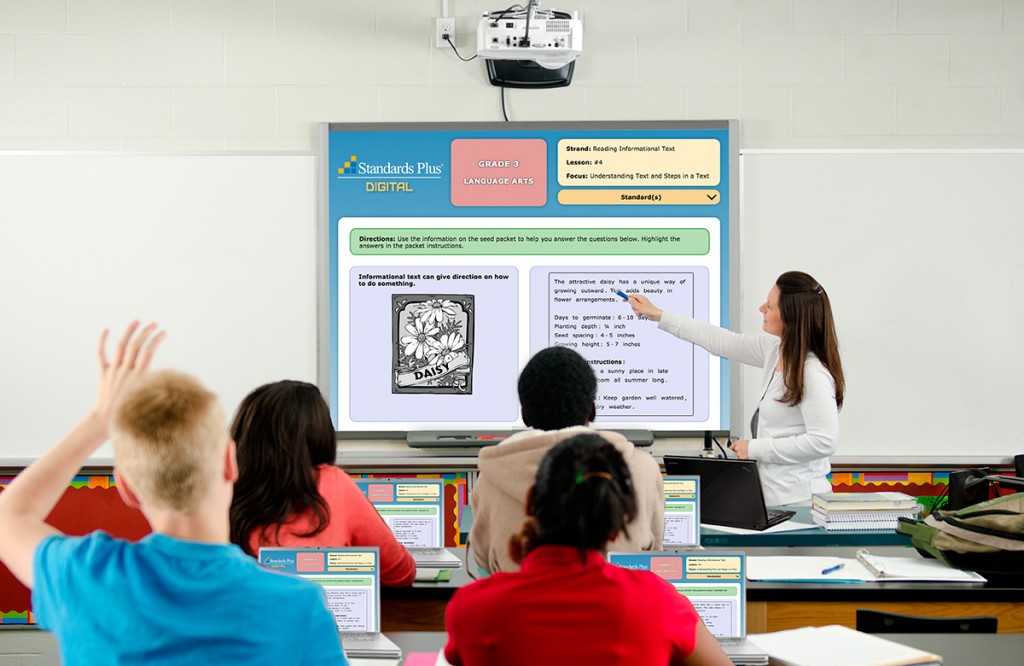
As a Standards Plus employee, I am privileged to interact with curriculum and instruction experts from around the country, and sometimes from around the world. One concept I have attempted to explore is “blended Learning.” I tried to discuss this concept with our expert staff on several occasions. Whenever I tried to describe my understanding of blended learning, I was adamantly informed that I was incorrect, but they were never able to agree on a common definition of the term. So I set out to discover the true meaning of blended learning. The following are examples of definitions of blended learning that I gathered from the Internet.
Blended Learning is:
- A hybrid teaching strategy that combines technology and teacher instruction in the 21st century classroom.
- Any formal education program in which a student learns at least in part through online learning, with some element of student control over time, place, path, and/or pace.
- A model, in which teachers determine the combination of technology and teacher led instruction that’s right for them and their students.
- The use of laboratory equipment or computers to complement the class sessions and strengthen the teaching process through practice and the application of theories learned in class.
One wise and poignant commentator defined blended learning as any combination of computers and teaching in a classroom, depending on the agenda of the person describing their specific instructional model. One wise and poignant commentator defined blended learning as any combination of computers and teaching in a classroom, depending on the agenda of the person describing their specific instructional model.
Unfortunately, blended learning has frequently evolved into something that minimizes the interaction between teachers and students and maximizes students’ interaction with on-line activities or programmed learning software. This distorted interpretation of blended learning is often driven by software companies with persuasive sales tactics that convince schools and school districts into believing a teacher’s primary role is to provide tech support for their student’s independent learning. For example, I found many variations of the following explanation of blended learning on the internet.
The teacher of record, or another adult, are on-site to provide face-to-face support on a flexible and adaptive as-needed basis as students move through an individually customized, fluid schedule. Some implementations advocate for minimal adult support.
Some current computerized programmed learning models are a throwback to B.F. Skinner’s original definition of programmed learning. Skinner in the 1950’s introduced a concept of a “teaching machine.”
The teaching machine is composed of mainly a program, which is a system of combined teaching and test items that carries the student gradually through the material to be learned. If the subject is correct, he/she gets reinforcement and moves on to the next question. If the answer is incorrect, the subject studies the correct answer to increase the chance of getting reinforced next time.
There is virtually no valid academic research to support the notion that students learn best when their primary exposure to content is through on-line videos, adaptive learning programs or other computer laden instructional models. There is a growing body of evidence that using computers in lieu of teacher-led instruction does not work for most students, especially high poverty students who have limited experience with technology, and little technology support in their homes. This is not to say that computers are not useful, or that it is not important to teach all children to use computers and the internet to enhance their learning. It is to say that computers and the internet should never replace teachers and their direct human to human interaction with students.
Research shows that effective teachers are the most important factor contributing to student achievement. Although curricula, reduced class size, district funding, family and community involvement all contribute to school improvement and student achievement, the most influential factor is the teacher. Educational Research Newsletter; Retrieved 06/01/19.
With Standards Plus Digital, students interact with computers and complete complex activities on their machines, but never to the exclusion of the teacher. That is our definition of blended learning.
Standards Plus believes in the overwhelming evidence that teachers matter. Although Standards Plus includes a digital version, all digital lessons are directly taught by live teachers in a classrooms interacting with real students. With Standards Plus Digital, students interact with computers and complete complex activities on their machines, but never to the exclusion of the teacher. That is our definition of blended learning.
